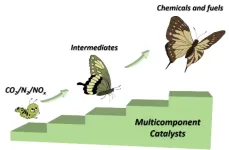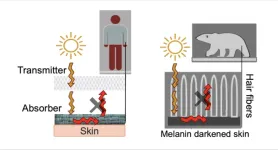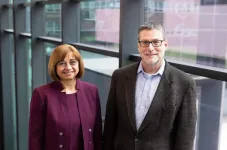(Press-News.org) For more than 100 million Americans who are obese, bariatric surgery may reverse complications related to diabetes, including regenerating damaged nerves, a Michigan Medicine study shows.
A research team led by the University of Michigan Health Department of Neurology followed more than 120 patients who underwent bariatric surgery for obesity over two years after the procedure. They found that all metabolic risk factors for developing diabetes, such as high glucose and lipid levels, improved outside of blood pressure and total cholesterol, according to results published in Diabetologia.
Investigators also found that patients two years removed from bariatric surgery showed improvements in peripheral neuropathy, a condition marked by damage to the nerves that go from the spinal cord all the way to the hands and feet.
“Our findings suggest that bariatric surgery likely enables the regeneration of the peripheral nerves and, therefore, may be an effective treatment for millions of individuals with obesity who are at risk of developing diabetes and peripheral neuropathy,” said senior author Brian C. Callaghan, M.D., M.S., a neurologist at University of Michigan Health and the Eva L. Feldman, M.D., Ph.D., Professor of Neurology at U-M Medical School.
Obesity is the second leading risk factor for peripheral neuropathy after diabetes, which affects more than 30 million Americans.
Researchers assessed two primary measures for peripheral neuropathy in patients with obesity by taking skin biopsies that show the nerve fiber density in the thigh and the leg. Two years after bariatric surgery, nerve fiber density improved in the thigh and remained stable in the leg.
Compared to previous studies of medical weight loss, when providers guide a patient’s weight loss goals, bariatric surgery led to better metabolic improvements and even greater improvements in peripheral neuropathy.
“Given the natural history of peripheral neuropathy decline in patients with obesity, even stability in nerve fiber density may be considered a successful result,” said first author Evan Reynolds, Ph.D., lead statistician for the NeuroNetwork for Emerging Therapies at Michigan Medicine. “Therefore, our findings of stability of nerve fiber density in the leg and improvement in nerve fiber density at the thigh indicate that bariatric surgery may be a successful therapy to improve or reverse peripheral neuropathy for patients with long-term metabolic impairment.”
Treatment for peripheral neuropathy currently focuses on pain, including oral medications such gabapentin and sodium channel blockers, topical analgesics and non-medical treatments, like exercise and cognitive behavioral therapy.
Additional authors include Maya Watanabe B.S., Mousumi Banerjee, Ph.D, Ericka Chant M.P.H., Emily Villegas-Umana B.S.N., R.N., Melissa A. Elafros M.D, Ph.D., Thomas W. Gardner M.D., M.S., Rodica Pop-Busui M.D., Ph.D., Subramaniam Pennathur M.D. and Eva Feldman, M.D., Ph.D., all of University of Michigan.
This study was supported by the National Institutes of Health, Juvenile Diabetes Research Foundation (JDRF) Center of Excellence at the University of Michigan, the A. Alfred Taubman Medical Research Institute, the Robert E. Nederlander Sr. Program for Alzheimer’s Research, the Andrea and Lawrence A. Wolfe Brain Health Initiative Fund, and the NeuroNetwork for Emerging Therapies. Callaghan consults for DynaMed, receives research support from the American Academy of Neurology and performs medical legal consultations including consultations for the Vaccine Injury Compensation Program.
Paper cited: “The effect of surgical weight loss on diabetes complications in individuals with class II/III obesity,” Diabetologia. DOI: 10.1007/s00125-023-05899-3
END
Bariatric surgery may reverse diabetes complications for people with obesity
Patients saw improvements in primary outcomes for peripheral neuropathy
2023-04-10
ELSE PRESS RELEASES FROM THIS DATE:
What is it good for? Absolutely one thing. Luna moths use their tails solely for bat evasion
2023-04-10
In a pair of complementary studies, researchers took a close look at Luna moth (Actias luna) tails through the eyes of birds and female moths to test the tails’ role in predation and sexual selection. Scientists have known for about a decade that Luna moths — and other related silkmoths — use their long, trailing tails to misdirect bat attacks.
“They have projections off the back of the hindwing that end in twisted, cupped paddles,” said Juliette Rubin, a doctoral student at the Florida Museum ...
Breaking inert bonds: Multicomponent catalysts pave the way for green chemistry and green carbon science
2023-04-10
The chemical industry has played a significant role in the development of society, but its impact on the environment has become a growing concern. Green chemistry and chemical engineering have opened up possibilities for sustainability through the transformation of renewable feedstocks into environmentally friendly chemicals. However, the inert bonds in molecules such as CO2 and N2 present challenges to their activation and conversion.
Electrochemical conversion provides a promising carbon-neutral route to upgrading green chemical sources with inert bonds to chemicals and fuels under ambient conditions. Multicomponent electrocatalysts have advantages over monocomponent catalysts, ...
New textile unravels warmth-trapping secrets of polar bear fur
2023-04-10
AMHERST, Mass. – Three engineers at the University of Massachusetts Amherst have invented a fabric that concludes the 80-year quest to make a synthetic textile modeled on Polar bear fur. The results, published recently in the journal ACS Applied Materials and Interfaces, are already being developed into commercially available products.
Polar bears live in some of the harshest conditions on earth, shrugging off Arctic temperatures as low as -50 Fahrenheit. While the bears have many adaptations that allow them to thrive when the temperature plummets, since the 1940s scientists have focused on one in particular: their fur. How, the scientific community ...
Navigating the cosmos with Georgia State’s CHARA Array
2023-04-10
ATLANTA—Plans are underway to add a seventh movable telescope to Georgia State University’s Center for High Angular Resolution Astronomy— known as the CHARA Array—that would increase the resolution, or the ability to see small objects, by a factor of three.
Located at Mount Wilson Observatory in Southern California and operated by Georgia State, the new telescope will be connected using fiber optics to transport the starlight, a technique that will serve as a pathfinder ...
BU doc honored by the Association of University Radiologists
2023-04-10
(Boston)— Priscilla J. Slanetz, MD, MPH, professor of radiology at Boston University Chobanian & Avedisian School of Medicine, was awarded the 2023 Association of Program Directors in Radiology (APDR) Achievement Award at the Association of University Radiologists’ annual meeting. The honor is given for outstanding service to APDR or to someone who has made significant contributions to the advancement of education in radiology.
Slanetz is a practicing breast radiologist at Boston Medical Center specializing in all aspects of breast imaging including screening, diagnostic evaluation and image-guided intervention, providing breast care to Boston’s most vulnerable ...
BU researcher awarded $1.5 million NIH grant
2023-04-10
Boston—Esther Bullitt, PhD, associate professor of pharmacology, physiology & biophysics at Boston University Chobanian & Avedisian School of Medicine, was awarded $1.5 million from the National Institutes of Health that will go toward the purchase of a cryogenic electron microscope. Additional funds have been pledged by University President Robert A. Brown and Professor and Chair of Pharmacology, Physiology & Biophysics Venetia Zachariou, PhD.
The FEI ThermoFisher Glacios-2 cryo-EM is capable of determining structures at near-atomic resolution. Researchers will use this new instrumentation to study cellular function and dysfunction, and to guide ...
New UK data system will help predict and prevent opioid overdoses in Kentucky
2023-04-10
LEXINGTON, Ky. (April 10, 2023) — University of Kentucky researchers are creating an innovative statewide surveillance system to inform prevention and response efforts aimed at reducing the burden of opioid use disorder in Kentucky.
The Rapid Actionable Data for Opioid Response in Kentucky (RADOR-KY) will use data from federal, state, and local sources to guide evidence-based practices aimed at preventing opioid overdoses in the Commonwealth. Phase one of the project is supported by a three-year $3.1 million grant from the National Institute on Drug Abuse (NIDA).
Driven by the COVID-19 pandemic and illegally manufactured fentanyl, drug overdose ...
AACR announces recipients of the 2023 AACR June L. Biedler Prize for Cancer Journalism
2023-04-10
PHILADELPHIA – The American Association for Cancer Research (AACR) is pleased to announce the recipients of the 2023 AACR June L. Biedler Prize for Cancer Journalism in the following categories:
Auditory Journalism
“‘No Mercy’ Chapter 5: With Rural Hospital Gone, Cancer Care Means a Daylong Trek”
Sarah Jane Tribble (Photo), Taunya English (Photo), Kaiser Health News
Greg Munteanu (Photo), Saint Louis Public Radio
Magazine
“One Man’s Search for the DNA Data That Could Save His Life”
By ...
Identifying cancer genes’ multiple personalities
2023-04-10
Mutations in our genes can lead to severe problems, like colon or liver cancer. But cancer is very complex. Mutations in the same genes can lead to different subtypes of tumors in different people. Currently, scientists don’t have a good way to produce such tumor subtypes for study in the lab.
Now, Cold Spring Harbor Laboratory Assistant Professor Semir Beyaz has created a new method to model certain liver cancer tumor subtypes using the gene-editing tool CRISPR-Cas9.
Genes contain the information our bodies need to create proteins. Highly similar proteins produced from the same gene are called isoforms. Different isoforms generate ...
Recent advances in mushroom research
2023-04-10
So, mushroom-zombies recently took over a fictional world, but in real life, they’re really not so scary. These fungi range in shape from broad, plate-like portobellos and gangly enokis to a version resembling a giant, shaggy lion’s mane. And now scientists are finding ways to grow mushrooms on new materials, as well as incorporate them in more sustainable products. Below are some recent papers published in ACS journals that report insights into additional applications for mushrooms. Reporters can request free access to these ...
LAST 30 PRESS RELEASES:
Study: Teens use cellphones for an hour a day at school
After more than two years of war, Palestinian children are hungry, denied education and “like the living dead”
The untold story of life with Prader-Willi syndrome - according to the siblings who live it
How the parasite that ‘gave up sex’ found more hosts – and why its victory won’t last
When is it time to jump? The boiling frog problem of AI use in physics education
Twitter data reveals partisan divide in understanding why pollen season's getting worse
AI is quick but risky for updating old software
Revolutionizing biosecurity: new multi-omics framework to transform invasive species management
From ancient herb to modern medicine: new review unveils the multi-targeted healing potential of Borago officinalis
Building a global scientific community: Biological Diversity Journal announces dual recruitment of Editorial Board and Youth Editorial Board members
Microbes that break down antibiotics help protect ecosystems under drug pollution
Smart biochar that remembers pollutants offers a new way to clean water and recycle biomass
Rice genes matter more than domestication in shaping plant microbiomes
Ticking time bomb: Some farmers report as many as 70 tick encounters over a 6-month period
Turning garden and crop waste into plastics
Scientists discover ‘platypus galaxies’ in the early universe
Seeing thyroid cancer in a new light: when AI meets label-free imaging in the operating room
Neutrophil-to-lymphocyte ratio may aid risk stratification in depressive disorder
2026 Seismological Society of America Annual Meeting
AI-powered ECG analysis offers promising path for early detection of chronic obstructive pulmonary disease, says Mount Sinai researchers
GIMM uncovers flaws in lab-grown heart cells and paves the way for improved treatments
Cracking the evolutionary code of sleep
Medications could help the aging brain cope with surgery, memory impairment
Back pain linked to worse sleep years later in men over 65, according to study
CDC urges ‘shared decision-making’ on some childhood vaccines; many unclear about what that means
New research finds that an ‘equal treatment’ approach to economic opportunity advertising can backfire
Researchers create shape-shifting, self-navigating microparticles
Science army mobilizes to map US soil microbiome
Researchers develop new tools to turn grain crops into biosensors
Do supervised consumption sites bring increased crime? Study suggests that’s a myth
[Press-News.org] Bariatric surgery may reverse diabetes complications for people with obesityPatients saw improvements in primary outcomes for peripheral neuropathy





